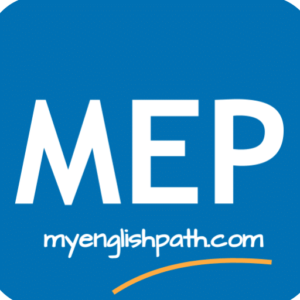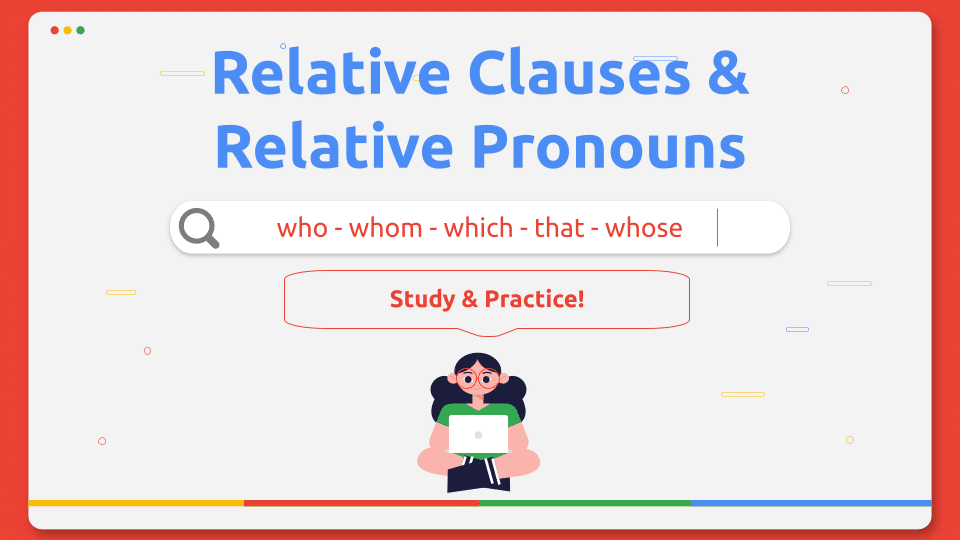
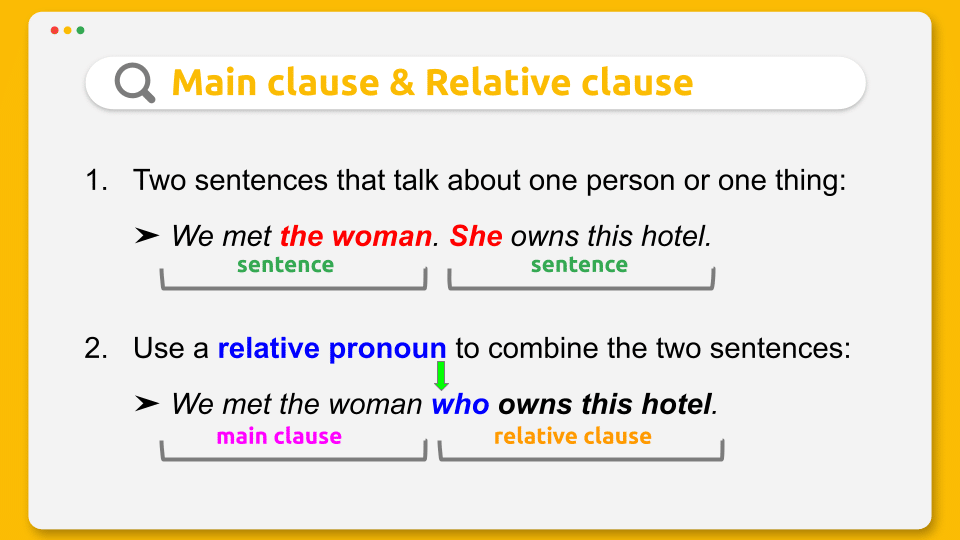
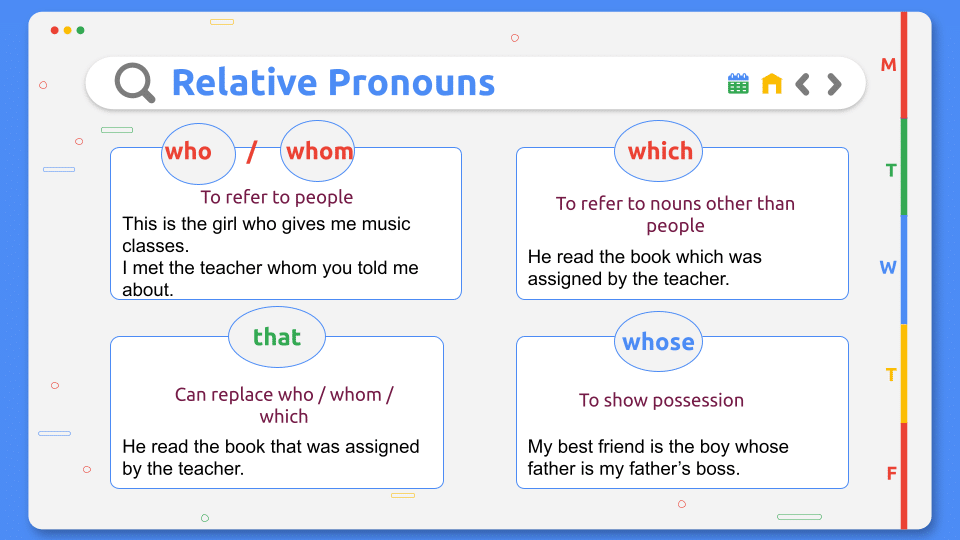
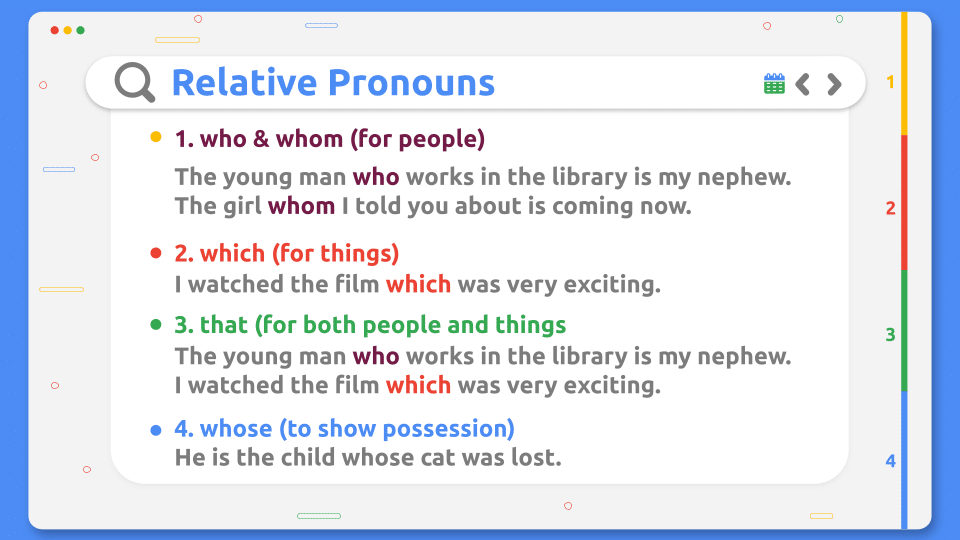
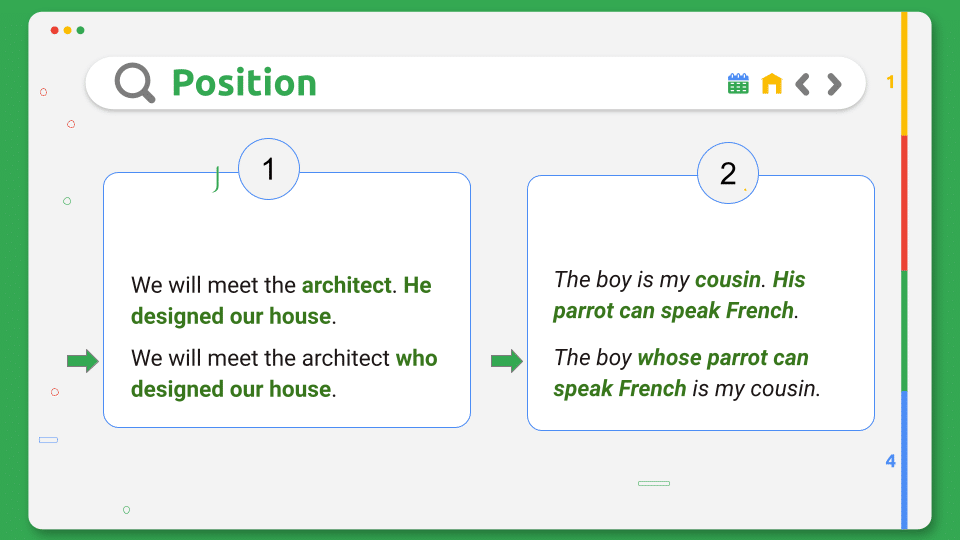
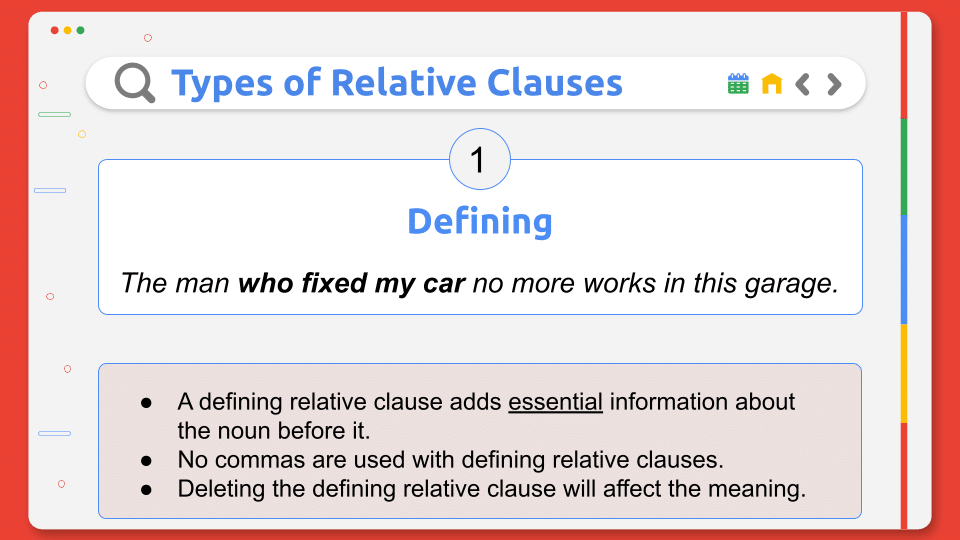
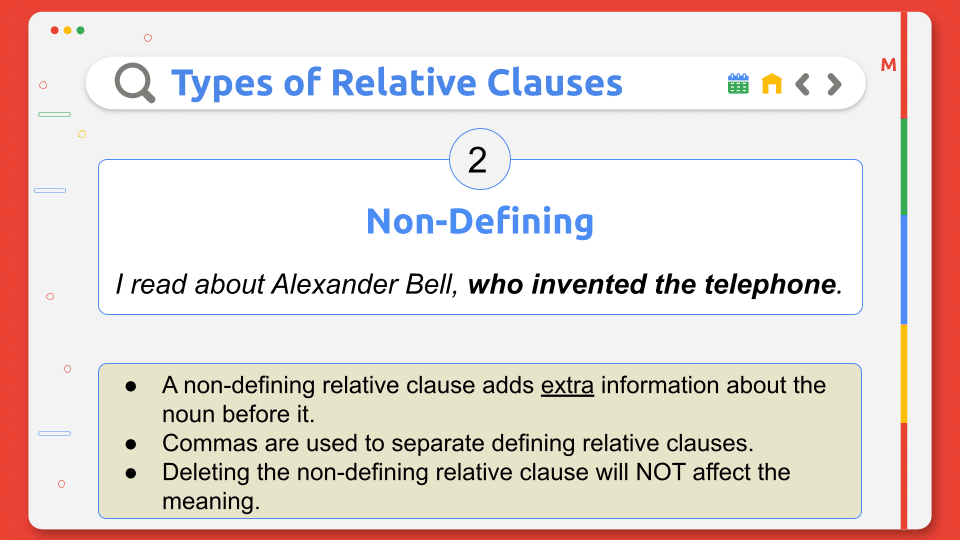
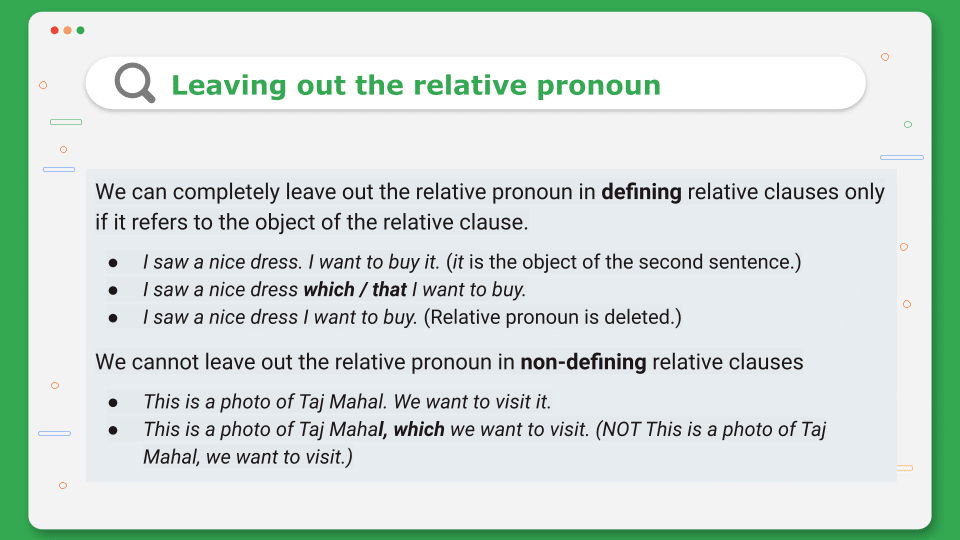
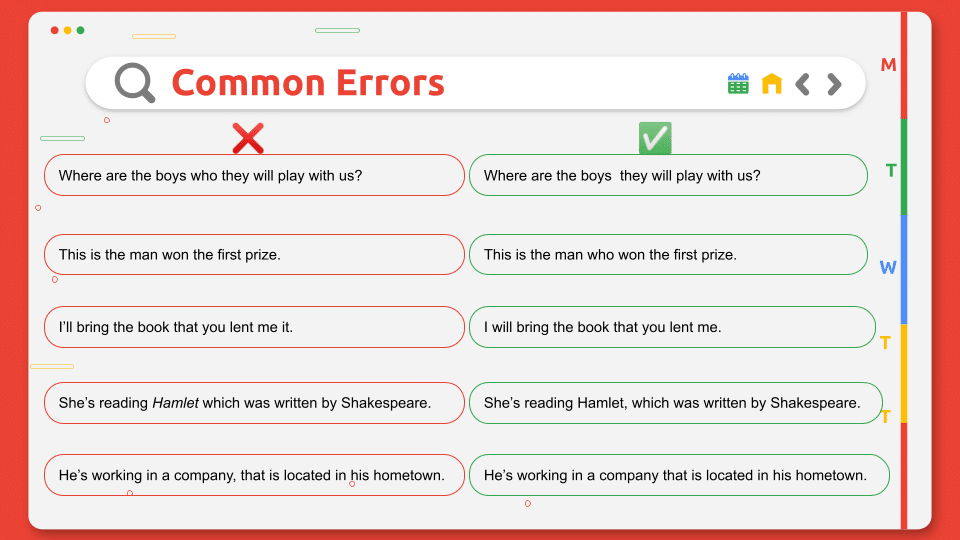
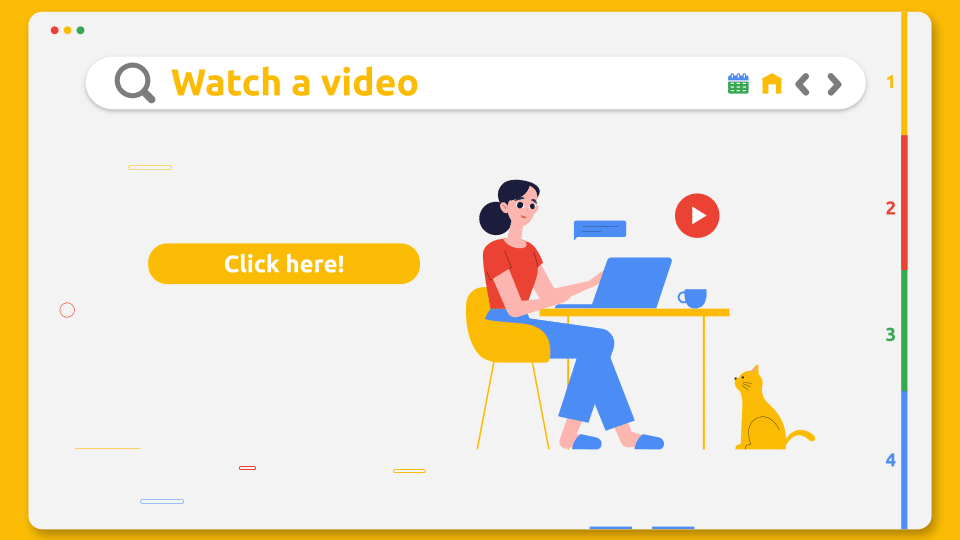
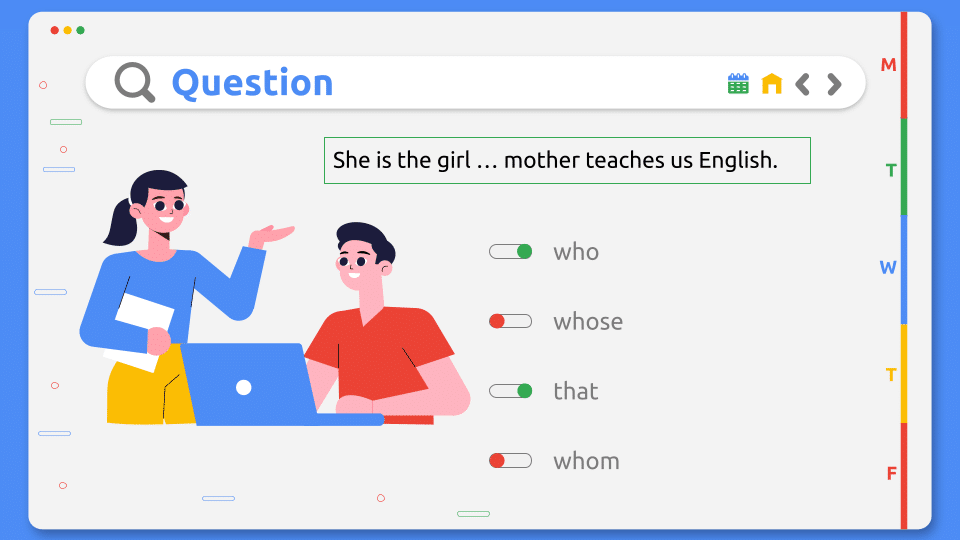
Table of Contents
Introduction
We use relative clauses to give additional information about a noun, such as a person or a thing.
- This is the man who helped us during the storm.
- I finished reading the book which is about animals.
We can combine (or join) two sentences to make one sentence of two clauses. One of the clauses is the main clause and the other is the subordinate clause (or relative clause).
- We met the woman. She owns this hotel. (two sentences about the woman)
- We met the woman who owns this hotel. (one sentence with two clauses: main clause and relative clause)

Relative pronouns
Relative pronouns introduce a relative clause. They include:
- who and whom for people
- which for all nouns except people
- that for all nouns
- whose to show possession
who / whom
The relative pronoun who is used to refer to people. It can replace both subject and object of the clause.
- This is the policeman who helped to catch the robbers. (who is the subject of the relative clause.)
- This is the policeman who (or whom) we saw at the metro station. (who / whom is the object of the relative clause.)
However, in formal English (written and spoken), the relative pronoun whom (NOT who) is used to refer to the object of the clause.
- This is the policeman whom we saw at the metro station.
which
We use the relative pronoun which to refer to all nouns except people.
- She dreams to buy a house which has a swimming pool. (which refers the house and it is the subject of the relative clause.)
- This is the restaurant which we like the most in the town. (which refers to the restaurant and it is the object of the relative clause.)
- Sue was looking for earrings which suit her outfit. (which refers to the earrings and it is the subject of the relative clause.)
that
The relative pronoun that is commonly used in place of who, whom and which in defining relative clauses.
- We talked to the students who / that are volunteering to clean the beach.
- She bought the laptop which / that has the latest version of the software.
In non-defining clauses, only who, whom and which can by used.
- He is writing a paper about Jules Verne, who is a French author. (NOT that)
- We live in Cairo, which is the capital of Egypt. (NOT that)
- I like to study in the dining room, which is the quietest room in the house. (NOT that)
whose
The relative pronoun whose is used to show that the noun in the main clause owns or is related to the noun in the relative clause.
It is used instead of possessive adjectives (my, your, our, his, her, its, their) with people, things and animals.
- She’s the girl. Her name is Mary.
- She‘s the girl whose name is Mary.
- We met the author. His book will be made a movie.
- We met the author whose book will be made a movie.
- My son studies in a school. Its principal is our neighbor.
- My son studies in the school whose principal is our neighbor.
Note: The relative pronoun whose is different from who’s,
Who’s (with apostrophe ‘) is the short form of who is or who has.
See more explanation of the difference between the two words in the Grammar FAQs page.
⇔ Take a quiz on relative clauses and relative pronouns.
⇔ Take a quiz on relative pronouns.
⇔ Take a quiz on relative clauses.
Prepositions in relative clauses
In very formal English, the preposition can come before the relative pronoun at the beginning of the relative clause. In this case, whom (NOT who) is used after the preposition.
- What is the name of the girl who you were talking to?
- What is the name of the girl whom you were talking to?
- What is the name of the girl that you were talking to?
- What is the name of the girl to whom you were talking? (very formal)
And here is another example:
- That is the woman who I submitted the form to.
- That is the woman whom I submitted the form to.
- That is the woman that I submitted the form to.
- That is the woman to whom I submitted the form. (NOT who or that)
This is an example with which:
- I have found the keys which I was looking for.
- I have found the keys that I was looking for.
- I have found the keys for which I was looking. (NOT that)
Types of relative clauses
There are two types of relative clauses that describe the nouns: defining and non-defining relative clauses.
In addition, relative clauses can refer to a whole sentence or clause, especially in speaking.
Defining relative clauses
Defining relative clauses add essential information about a noun.
If we remove the defining relative clause, the sentence does not make sense.
- The man who fixed my car no more works in this garage. (who fixed my car is important to tell us which man; if we remove the relative clause, the sentence will not give the same meaning.)
- Do you remember the movie that we watched together last week? (that we watched together last week defines which movie.)

Non-defining relative clauses
Non-defining relative clauses add extra information to a noun or noun phrase.
This extra information is not essential.
If we remove the relative clause, the sentence still makes sense.. This type of clause is more common in written English.
- I read about Alexander Bell, who invented the telephone. (who invented the telephone does not define Alexander Bell; it only adds information about him.)
- We arranged a party for our father, who is travelling next week. (who is travelling next week adds information but does not define our father.)
Note:
The structure of both defining and non-defining relative clauses is the same. But they are different in the use of punctuation.
With non-defining relative clauses, we separate the clause with commas.
Also, we cannot use that in this type of clause.
- I read about Alexander Bell, who invented the telephone. (NOT I read about Alexander Bell, that invented the telephone.)

Position
When we combine two sentences into one sentence of two clauses (main clause and relative clause), we place the relative clause close to the noun that it describes.
- We will meet the architect. He designed our house.
- We will meet the architect who designed our house.
- Do you know the man? His dog barks all night.
- Do you know the man whose dog barks all night?
In the two examples above, the nouns we want to describe come at the end of the first sentence. So we had only to remove the full-stop and put the relative pronoun instead of the subject of the second sentence.
Sometimes the relative clause describes the subject of the main clause. In these cases, we insert the relative clause after the subject and before the main verb of the main clause.
- The students were honored by the principal. They volunteered in the environment club activities.
- The students who volunteered in the environment club activities were honored by the principal.
- The boy is my cousin. His parrot can speak French.
- The boy whose parrot can speak French is my cousin.
Relative clauses referring to a whole sentence
Relative clause can refer to a whole sentence or group of sentences. (That’s why they are sometimes called sentential relative clauses).
We introduce this type of relative causes with the relative pronoun which.
In writing, we add a comma before which.
- They were excited about the meeting, which is understandable. (which refers to the whole sentence before the comma.)
- Leena refused the offer, which was upsetting to her boss. (which refers to the whole sentence before the comma.)
In speaking we sometimes pause before which clauses.
In informal speaking, we use which to express an opinion or evaluation of what has been said.
- A: Your parcel will be delivered to your door early in the morning-say at 8.
- B: Which is perfect because I have to leave to work at 9. (which refers to what A has said about the delivery time.)
In the conversation below, the first speaker (A) comments with a which clause after the listener (B) responded.
- A: I was told my account was hacked.
- B: Really?
- A: Which turned to be fake news. (Which clause is a comment on what A said at the beginning.)
Leaving out the relative pronoun
In informal speech and writing, we can completely leave out the relative pronoun in defining relative clauses only when it refers the object of the relative clause.
- I saw a nice dress. I want to buy it. (it is the object of the second sentence.)
- I saw a nice dress which / that I want to buy. (The relative pronoun refers to the object of the defining relative clause.)
- I saw a nice dress I want to buy. (Relative pronoun is deleted.)
In the following example, however, we cannot omit the relative pronoun because it replaces the subject of the defining relative clause.
- They produced a movie. It discusses human trafficking. (It is the subject of the second sentence.)
- They produced a movie which/ that discusses human trafficking. (The relative pronoun replaces the object of the defining relative clause, so it cannot be deleted.)
On the other hand, we cannot leave out the relative pronoun in non-defining relative clauses
- This is a photo of Taj Mahal. We want to visit it.
- This is a photo of Taj Mahal, which we want to visit. (NOT This is a photo of Taj Mahal, we want to visit.)
Relative adverbs
Relative adverbs describe time, place and reason. They are:
- when for time
- where for place
- why for reason
They introduce relative clauses, and they usually replace the formal structure preposition + relative pronoun, such as on which, at which, for which, etc.
when
We use when after words that refer to time, such as year, day, time, moment, winter, etc.
It can be omitted or replaced by that.
- I’ll never forget the day. I got my first job on that day.
- Ill never forget the day on which I got my first job.
- Ill never forget the day when I got my first job.
- I’ll never forget the day that I got my first job.
- Ill never forget the day I got my first job.
where
We use where after words that refer to place, such as place, house, school, town, country, etc.
- This is the restaurant. They usually meet in this restaurant.
- This is the restaurant in which they usually meet.
- This is the restaurant where they usually meet.
why
We use why before the reason of something.
- I don’t understand the reason. They cancelled the meeting for that reason.
- I don’t understand the reason for which they cancelled the meeting.
- I don’t understand the reason why they cancelled the meeting.
- I don’t understand why they cancelled the meeting.
Common errors
Here are some common errors people make when they use relative clauses and pronouns and how to correct them.
1. using a pronoun or noun along with the relative pronoun when it is a subject
Χ Where are the boys who they will play with us?
√ Where are the boys who will play with us?
2. leaving out the relative pronoun when it is the subject of the relative clause
Χ This is the man won the first prize.
√ This is the man who won the first prize.
3. keeping the object in the relative clause along with the relative pronoun that refers to it
Χ I will bring the book that you lent me it.
√ I will bring the book that you lent me.
4. not using commas to separate a non-defining clauses in writing
Χ She was reading Hamlet which was written by Shakespeare.
√ She was reading Hamlet, which was written by Shakespeare.
5. using commas to separate defining clauses in writing
Χ He works in a company, that is located in his hometown.
√ He works in a company that is located in his hometown.
6. using which to refer to adverb of time or place without a preposition
Χ Do you remember the day which we received the offer?
√ Do you remember the day on which we received the offer?
√ Do you remember the day when we received the offer?
